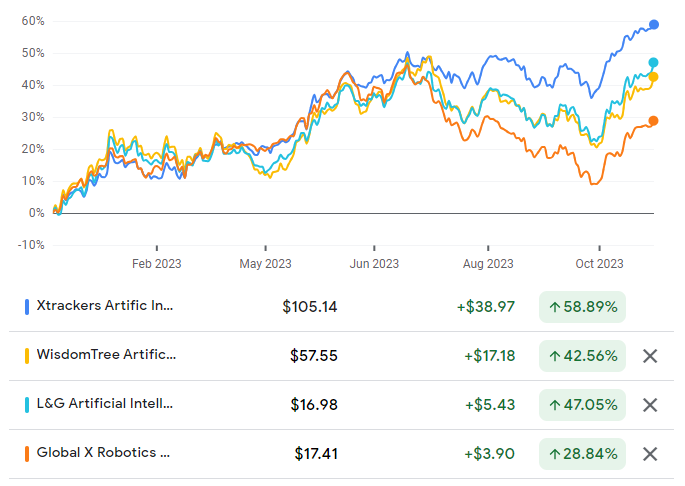Artificial Intelligence ETFs have seen a huge performance dispersion so far this year with the top-performing thematic strategies returning more than double the lowest.
The theme has attracted huge attention in 2023, driving much of the returns of the ‘magnificent seven’ in the US – Apple, Amazon, Meta, Nvidia, Microsoft, Alphabet and Tesla – with AI solutions such as ChatGPT propelling the tech stock rally.
While this has been reflected in the performance of most AI ETFs, some that offer a more regionally diverse approach to the technology have underperformed.
For example, the best performing is the £1.3bn Xtrackers Artificial Intelligence & Big Data UCITS ETF (XAIX) which has returned 58.9% this year, as at 29 November, versus 28% for the Global X Robotics & Artificial Intelligence UCITS ETF (BOTZ), the lowest across ETFs tracking the theme.
The other two AI ETFs in Europe, the L&G Artificial Intelligence UCITS ETF (AIAI) and the WisdomTree Artificial Intelligence UCITS ETF (INTL), have returned 47% and 42.6%, respectively.
Chart 1: AI ETF performance dispersion

The ‘magnificent seven’
XAIX is arguably a less pure-play strategy than its counterparts, with its outperformance for the most part driven by its higher weighting to US equities at 83%.
Only AIAI has a similar weighting, also 83%, versus 64.4% for INTL and 50.8% for BOTZ.
XAIX’s top five holdings are all members of the ‘magnificent seven’ with Meta (4.8%), Nvidia (4.6%), Alphabet (4.6%), Amazon (4.6%) and Microsoft (4.5%) the most heavily weighted stocks. Apple is also a top 10 holding at 4%.
Comparatively, AIAI has three of the seven stocks in its top 10 versus one (Nvidia) for BOTZ and zero for INTL.
The ‘magnificent seven’ accounted for 100% of the gains for the S&P 500 in H1 and added $3.7trn to the market cap of the Nasdaq 100 over the same period, according to Ben Bakkum, lead investing researcher at JP Morgan.
It also resulted in “special rebalance” of the flagship US tech index in a bid to address overconcentration concerns.
Nvidia has been the poster child of this rise and is up 237% year to date, breaking the $1trn market cap barrier.
The chipmaker sailed past analyst quarterly earnings predictions earlier this week and raised its guidance over the next three months as AI continues to drive growth.
Chart 2: ‘Magnificent seven’ driving AI stock performance

Pure-play opportunities
While the mega-cap tech stocks have powered most of the returns for the AI ETFs, there are hopes that more pure-play AI companies could join the rally in the future.
Pierre Debru, head of quantitative research and multi-asset solutions at WisdomTree, said there could still be upside in the theme, while investors should consider the short-term positive or negative performance with their long-term investment horizon.
“The story for tech investors in 2023 has been driven by AI yet it has been the mega-cap tech stocks that have benefited most, rather than those pure play AI companies suggesting there is still upside to be had for those interested in the theme,” he said.
“For those with long-term conviction in AI, there are smaller and exciting tech stocks providing pure exposure to artificial intelligence that have not necessarily participated in the rally we have seen.”






